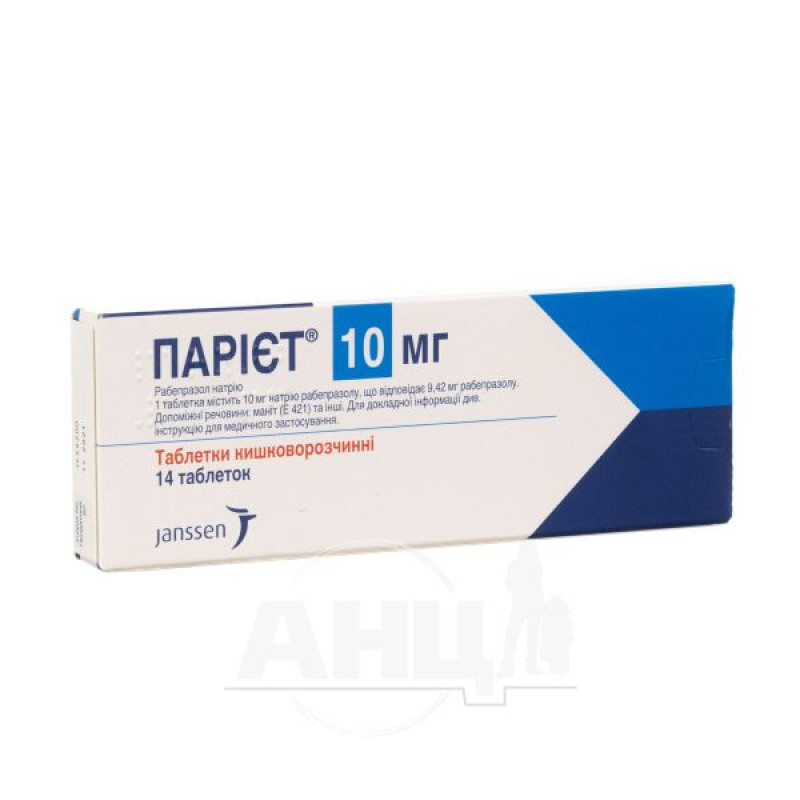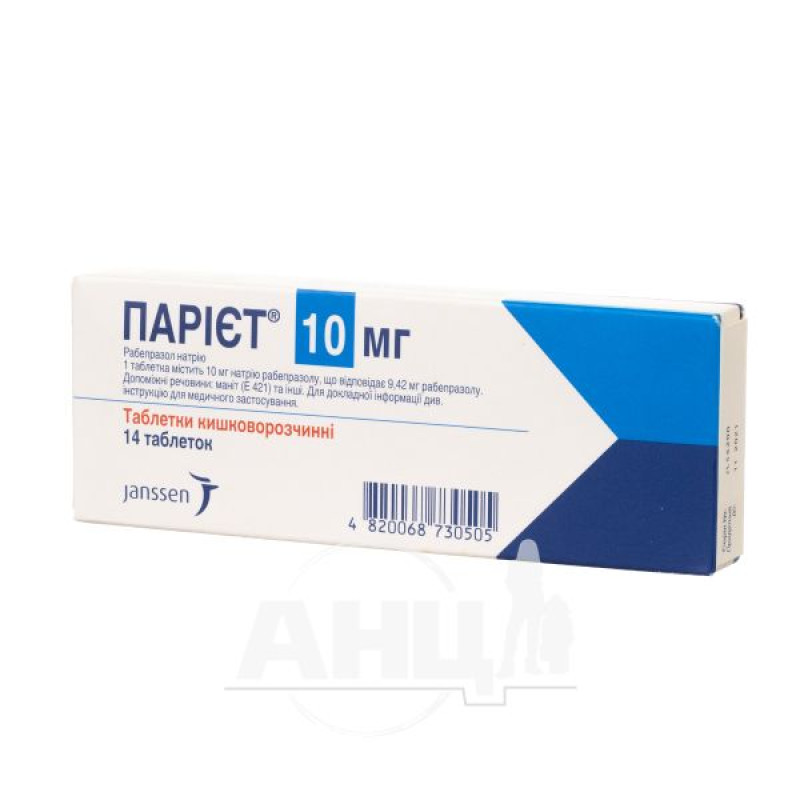Pariet enteric-coated tablets 10 mg No. 14

Pharmacological properties
Pariet belongs to the class of antisecretory compounds, which are chemically substituted benzimidazoles, inhibits the secretion of gastric acid by specific inhibition of the enzyme h + / k + -ATPase on the secretory surface of the parietal cells of the stomach. This enzyme system is considered an acid (proton) pump, therefore Pariet is classified as a gastric proton pump inhibitor, which blocks the final stage of gastric acid production. The drug does not have anticholinergic activity and is not an antagonist of histamine H2 receptors. It has been experimentally established that after administration into the body, rabeprazole sodium quickly disappears from both blood plasma and the gastric mucosa. Rabeprazole sodium has a weakly alkaline reaction, is rapidly absorbed in the digestive tract and concentrates in parietal cells. Rabeprazole sodium is converted to the active sulfenamide form by protonation and thus reacts with available cysteine residues of the proton pump.
antisecretory activity
After oral administration of 20 mg of Pariet, the antisecretory effect occurs within 1 hour and reaches a maximum after 2-4 hours. Inhibition of basal and food-stimulated secretion of gastric acid 23 hours after taking the first dose of Pariet was 62 and 82%, respectively, and the duration of this effect reached 48 hours. The inhibitory effect of Pariet on gastric acid secretion increases slightly during daily administration of 1 tablet, and stable inhibition of secretion is achieved 3 days after the start of taking this drug. After stopping Pariet, secretory activity normalizes within 2-3 days.
Effect on serum gastrin concentration
In clinical trials, patients received 10 or 20 mg of Pariet once daily for up to 12 months. During the first 2-8 weeks of therapy, serum gastrin concentrations increased, reflecting suppression of gastric acid secretion. Gastrin concentrations returned to baseline levels, usually within 1-2 weeks after the end of treatment. Examination of gastric fundus and antrum biopsies from more than 500 patients treated with Pariet or a comparator for up to 8 weeks revealed no significant changes in histological changes, severity of gastritis, incidence of atrophic gastritis, intestinal metaplasia, or prevalence of H. pylori infection. Long-term treatment of more than 250 patients for up to 36 months also showed no significant changes in these findings.
absorption
Due to the special dosage form, absorption of rabeprazole sodium occurs in the intestine. This dosage form protects rabeprazole sodium from the effects of hydrochloric acid, which breaks down this compound. It is rapidly absorbed from the intestine and its peak plasma concentrations are reached approximately 3.5 hours after administration at a dose of 20 mg. The maximum plasma concentration and AUC of rabeprazole are linear in the dose range of 10-40 mg. Absolute bioavailability after oral administration of 20 mg (compared to intravenous administration) is about 52%, largely due to first-pass metabolism through the liver. In addition, bioavailability does not increase with repeated administration of Pariet. In healthy volunteers, the plasma half-life was approximately 1 hour (range 0.7 to 1.5 hours), and the total clearance was 283 ± 98 ml/min. Absorption of Pariet does not depend on food intake and time of drug administration. The degree of binding of rabeprazole sodium to plasma proteins reaches 97%. The main metabolites detected in blood plasma are thioester and carboxylic acid, and secondary metabolites, which are determined in low concentrations, are represented by sulfonic, dimethylthioester and mercapturic acid conjugate. Only the dimethyl metabolite (M3) has insignificant antisecretory activity, but it is not determined in blood plasma. After a single dose of 20 mg, rabeprazole is not determined in the urine in unchanged form. Approximately 90% of the administered dose is excreted in the urine mainly in the form of two metabolites: a conjugate of mercapturic acid and carboxylic acid; in addition, two more unidentified metabolites have been identified in experimental studies. The rest of the drug is excreted from the body with feces. The pharmacokinetics of rabeprazole do not differ between men and women.
Kidney failure
In patients with stable end-stage renal disease requiring maintenance hemodialysis, the distribution of Pariet was very similar to that in healthy volunteers. The AUC of rabeprazole sodium and the maximum blood concentration in such patients were almost 35% higher compared to those in healthy volunteers. The elimination half-life averaged 0.82 hours in healthy volunteers, 0.95 hours in patients on hemodialysis, and 3.6 hours after dialysis. The dose calculated for patients with renal failure on hemodialysis was approximately twice that in healthy volunteers.
After a single dose of Pariet at a dose of 20 mg in patients with moderate chronic liver damage compared with healthy volunteers, the AUC increased by twofold and a 2-3-fold increase in the half-life of rabeprazole sodium was noted. Thus, with daily administration of the drug at a dose of 20 mg for 7 days, the AUC should increase by at least 1.5 times and the maximum plasma concentration - up to 1.2. The half-life of Pariet in patients with liver damage was 12.3 hours compared with 2.1 hours in healthy volunteers. The pharmacodynamic response (pH-metry of gastric juice) for individuals of both groups was therapeutically comparable.
In elderly patients, the elimination of the drug is somewhat slower. After 7 days of taking rabeprazole sodium at a dose of 20 mg/day in elderly people, the AUC was approximately twice as high and the maximum plasma concentration increased by 60% compared with that in healthy young volunteers. However, there is no evidence of cumulation of rabeprazole sodium.
Currently, there is no data on the development of systemic effects from the CNS, cardiovascular and respiratory systems caused by the use of rabeprazole sodium. Oral administration of rabeprazole sodium at a dose of 20 mg/day for 2 weeks does not affect thyroid function, carbohydrate metabolism, as well as the blood concentration of parathyroid hormone, cortisone, estrogen, testosterone, prolactin, cholecystokinin, secretin, glucagon, FSH, LH, renin, aldosterone and somatotropic hormone.
CYP2C19 polymorphism
When rabeprazole sodium was administered at a dose of 20 mg/day for 7 days to patients with reduced CYP2C19 activity, the AUC and half-life were approximately 1.9 and 1.6 times higher, respectively, compared with patients with rapid rabeprazole metabolism; however, the maximum plasma concentration increased by only 40%.
Indication
Peptic ulcer localized in the stomach or duodenum; gastroesophageal reflux disease (esophageal ulcer, erosive esophagitis); in combination with antibacterial agents for the eradication of H. pylori in patients with peptic ulcer and chronic gastritis, for healing of the ulcer defect and prevention of recurrence of ulcers associated with H. pylori.
Application
Adults, including elderly patients, with active gastric and duodenal ulcers are prescribed 1 tablet (20 mg) once a day in the morning. The duration of treatment with duodenal ulcers is an average of 4 weeks (in the absence of scarring - up to 8 weeks).
In most patients with peptic ulcer disease, healing occurs within 6 weeks, but some patients may require additional treatment with Pariet for an additional 6 weeks.
For GERD or ulcerative GERD, 1 tablet of Pariet (20 mg) is prescribed once a day for 4-8 weeks. The maintenance dose for this pathology is 20 mg/day for a long time.
The following treatment regimens are recommended for the eradication of H. pylori:
Pariet 20 mg 2 times a day + clarithromycin 500 mg 2 times a day + amoxicillin 1 g 2 times a day for 7 days;
Pariet 20 mg 2 times a day + clarithromycin 500 mg 2 times a day + metronidazole 400 mg 2 times a day for 7 days.
The optimal eradication result (more than 90% of cases) was observed when using the first regimen.
Eradication of H. pylori by any of the above regimens results in scarring of duodenal or gastric ulcers without the need for additional continuation of antiulcer therapy.
The tablets are taken in the morning, before meals, without chewing or crushing.
Moderately severe liver or kidney dysfunction does not require dose adjustment. There is no sufficient experience with the use of the drug in children, therefore, prescribing the drug to children is not recommended.
Contraindication
Pregnancy and breastfeeding; hypersensitivity to rabeprazole or benzimidazoles, pregnancy and breastfeeding.
Side effects
It is usually well tolerated by patients. Side effects are usually mild or moderate in severity and disappear quickly.
The most common side effects (incidence 5% or more) were headache, diarrhea, and nausea; with a frequency of 2 to 5%, rhinitis, abdominal pain, asthenia, flatulence, pharyngitis, vomiting, back pain, dizziness, flu-like syndrome, infections, cough, constipation, and insomnia. With a frequency of less than 1%, skin rashes, myalgia, chest pain, dry mouth, dyspepsia, increased nervous excitability, drowsiness, bronchitis, sinusitis, chills, belching, calf muscle cramps, urinary tract infections, arthralgia, and fever were noted. In isolated cases, anorexia, gastritis, weight gain, depression, itching, visual and taste disturbances, stomatitis, increased sweating and leukocytosis were noted, however, a connection with Pariet intake was established only for headache, diarrhea, abdominal pain, asthenia, flatulence, skin rash and dry mouth.
Special instructions
Improvement of symptoms after the use of Pariet can also be observed in the presence of malignant neoplasms of the stomach, therefore, before starting therapy, it is necessary to exclude such diseases.
Caution is recommended in the early stages of Pariet therapy in patients with severe renal impairment.
The safety of rabeprazole during pregnancy has not been established. It has been experimentally established that the drug can penetrate the placental barrier, therefore the use of Pariet during pregnancy is contraindicated.
It is not known whether rabeprazole sodium is able to penetrate into breast milk, therefore Pariet should not be prescribed during breastfeeding.
Given the side effect profile inherent in rabeprazole, Pariet should not have a negative effect on the ability to drive or operate potentially dangerous machinery. However, in case of drowsiness while taking the drug, it is recommended to avoid such activities.
Interactions
The results of a study in healthy volunteers indicate that Pariet does not enter into clinically significant interactions with other drugs metabolized by CYP450 enzymes, such as warfarin, phenytoin, theophylline and diazepam.
The use of Pariet causes a pronounced and prolonged decrease in gastric acid production. Therefore, it may interact with drugs whose absorption depends on the pH of the gastric contents, so studies have been conducted to study the likelihood of such an interaction. Taking Pariet caused a 33% decrease in the plasma concentration of ketoconazole and a 22% increase in the minimum concentrations of digoxin in healthy volunteers. Thus, some patients may need to adjust the dose when taking these drugs with Pariet. In a special study, no interaction of Pariet with antacids was detected. In addition, no clinically significant interaction of Pariet with food was detected.
In vitro studies with human liver microsomes have shown that rabeprazole sodium is metabolized by CYP450 isoenzymes (CYP2C9 and CYP3A). The results of the studies suggest that Pariet has a low potential for drug interactions; its effect on cyclosporine metabolism is similar to that of other proton pump inhibitors.
Overdose
Doses up to 80 mg/day were well tolerated by patients. The specific antidote for Pariet is unknown. In case of overdose, symptomatic and supportive therapy should be carried out. The drug is highly bound to plasma proteins, so dialysis is ineffective.
Storage conditions
At a temperature not exceeding 25 °C.
There are no reviews for this product.
There are no reviews for this product, be the first to leave your review.
No questions about this product, be the first and ask your question.







